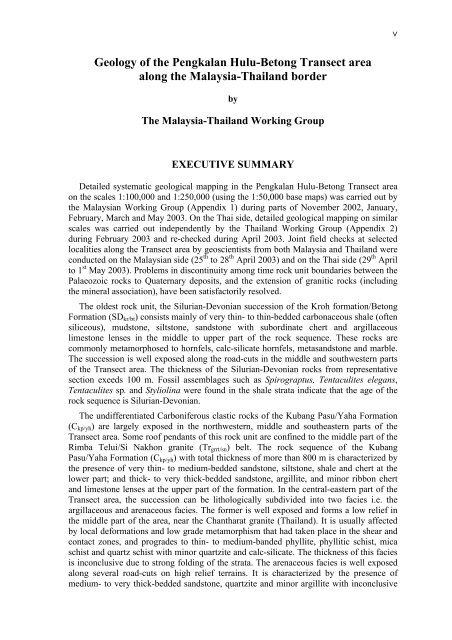GEOLOGY OF THE PENGKALAN HULU-BETONG TRANSECT ...
GEOLOGY OF THE PENGKALAN HULU-BETONG TRANSECT ...
GEOLOGY OF THE PENGKALAN HULU-BETONG TRANSECT ...
Create successful ePaper yourself
Turn your PDF publications into a flip-book with our unique Google optimized e-Paper software.
Geology of the Pengkalan Hulu-Betong Transect area<br />
along the Malaysia-Thailand border<br />
by<br />
The Malaysia-Thailand Working Group<br />
EXECUTIVE SUMMARY<br />
Detailed systematic geological mapping in the Pengkalan Hulu-Betong Transect area<br />
on the scales 1:100,000 and 1:250,000 (using the 1:50,000 base maps) was carried out by<br />
the Malaysian Working Group (Appendix 1) during parts of November 2002, January,<br />
February, March and May 2003. On the Thai side, detailed geological mapping on similar<br />
scales was carried out independently by the Thailand Working Group (Appendix 2)<br />
during February 2003 and re-checked during April 2003. Joint field checks at selected<br />
localities along the Transect area by geoscientists from both Malaysia and Thailand were<br />
conducted on the Malaysian side (25 th to 28 th April 2003) and on the Thai side (29 th April<br />
to 1 st May 2003). Problems in discontinuity among time rock unit boundaries between the<br />
Palaeozoic rocks to Quaternary deposits, and the extension of granitic rocks (including<br />
the mineral association), have been satisfactorily resolved.<br />
The oldest rock unit, the Silurian-Devonian succession of the Kroh formation/Betong<br />
Formation (SDkr/bt) consists mainly of very thin- to thin-bedded carbonaceous shale (often<br />
siliceous), mudstone, siltstone, sandstone with subordinate chert and argillaceous<br />
limestone lenses in the middle to upper part of the rock sequence. These rocks are<br />
commonly metamorphosed to hornfels, calc-silicate hornfels, metasandstone and marble.<br />
The succession is well exposed along the road-cuts in the middle and southwestern parts<br />
of the Transect area. The thickness of the Silurian-Devonian rocks from representative<br />
section exeeds 100 m. Fossil assemblages such as Spirograptus, Tentaculites elegans,<br />
Tentaculites sp. and Styliolina were found in the shale strata indicate that the age of the<br />
rock sequence is Silurian-Devonian.<br />
The undifferentiated Carboniferous clastic rocks of the Kubang Pasu/Yaha Formation<br />
(Ckp/yh) are largely exposed in the northwestern, middle and southeastern parts of the<br />
Transect area. Some roof pendants of this rock unit are confined to the middle part of the<br />
Rimba Telui/Si Nakhon granite (Trgrrt/sn) belt. The rock sequence of the Kubang<br />
Pasu/Yaha Formation (Ckp/yh) with total thickness of more than 800 m is characterized by<br />
the presence of very thin- to medium-bedded sandstone, siltstone, shale and chert at the<br />
lower part; and thick- to very thick-bedded sandstone, argillite, and minor ribbon chert<br />
and limestone lenses at the upper part of the formation. In the central-eastern part of the<br />
Transect area, the succession can be lithologically subdivided into two facies i.e. the<br />
argillaceous and arenaceous facies. The former is well exposed and forms a low relief in<br />
the middle part of the area, near the Chantharat granite (Thailand). It is usually affected<br />
by local deformations and low grade metamorphism that had taken place in the shear and<br />
contact zones, and progrades to thin- to medium-banded phyllite, phyllitic schist, mica<br />
schist and quartz schist with minor quartzite and calc-silicate. The thickness of this facies<br />
is inconclusive due to strong folding of the strata. The arenaceous facies is well exposed<br />
along several road-cuts on high relief terrains. It is characterized by the presence of<br />
medium- to very thick-bedded sandstone, quartzite and minor argillite with inconclusive<br />
v



